Other years |
| Countries of the United Kingdom |
| Scotland |
| Sport |
| 1782 English cricket season |
Events from the year 1782 in Great Britain. The American Revolutionary War draws to a close.
Other years |
| Countries of the United Kingdom |
| Scotland |
| Sport |
| 1782 English cricket season |
Events from the year 1782 in Great Britain. The American Revolutionary War draws to a close.



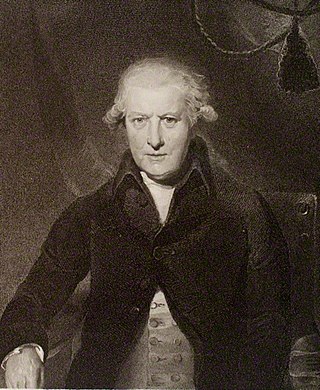
William Wildman Shute Barrington, 2nd Viscount Barrington, PC, was a British politician who sat in the House of Commons for 38 years from 1740 to 1778. He was best known for his two periods as Secretary at War during Britain's involvement in the Seven Years War and American War of Independence.
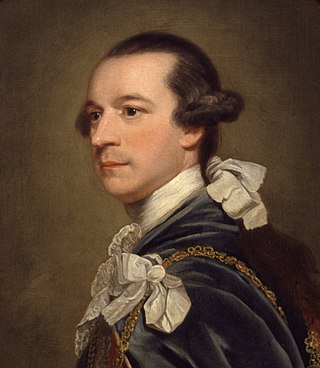
Charles Watson-Wentworth, 2nd Marquess of Rockingham, was a British Whig statesman and magnate, most notable for his two terms as prime minister of Great Britain. He became the patron of many Whigs, known as the Rockingham Whigs, and served as a leading Whig grandee. He served in only two high offices during his lifetime but was nonetheless very influential during his one and a half years of service.
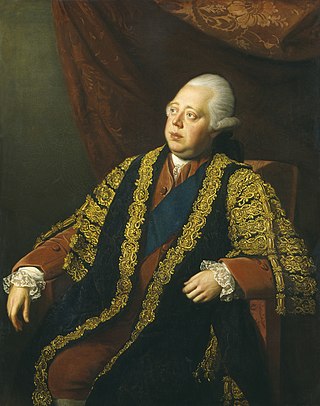
Frederick North, 2nd Earl of Guilford, better known by his courtesy title Lord North, which he used from 1752 to 1790, was Prime Minister of Great Britain from 1770 to 1782. He led Great Britain through most of the American War of Independence. He also held a number of other cabinet posts, including Home Secretary and Chancellor of the Exchequer.

William Henry Cavendish Cavendish-Bentinck, 3rd Duke of Portland, was a British Whig and then a Tory politician during the late Georgian era. He served as chancellor of the University of Oxford (1792–1809) and as Prime Minister of Great Britain (1783) and then of the United Kingdom (1807–1809). The gap of 26 years between his two terms as prime minister is the longest of any British prime minister. He was also the fourth great-grandfather of King Charles III through his great-granddaughter Cecilia Bowes-Lyon, Countess of Strathmore and Kinghorne.

William Petty Fitzmaurice, 1st Marquess of Lansdowne,, was an Anglo-Irish Whig statesman who was the first home secretary in 1782 and then prime minister from 1782 to 1783 during the final months of the American War of Independence. He succeeded in securing peace with America and this feat remains his most notable legacy.
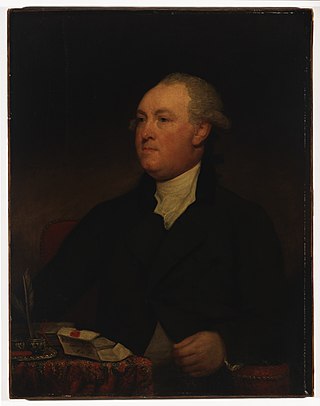
Thomas Townshend, 1st Viscount Sydney was a British politician who sat in the House of Commons from 1754 to 1783 when he was raised to the peerage as Baron Sydney. He held several important Cabinet posts in the second half of the 18th century. The cities of Sydney in Nova Scotia, Canada, and Sydney in New South Wales, Australia were named in his honour, in 1785 and 1788, respectively.

Marquess of Rockingham, in the County of Northampton, was a title in the Peerage of Great Britain. It was created in 1746 for Thomas Watson-Wentworth, 1st Earl of Malton. The Watson family descended from Lewis Watson, Member of Parliament for Lincoln. He was created a Baronet, of Rockingham Castle in the County of Northampton, in the Baronetage of England in 1621. In 1645 he was further honoured when he was raised to the Peerage of England as Baron Rockingham. The third Baron served as Lord-Lieutenant of Kent. In 1714 he was created Baron Throwley, Viscount Sondes and Earl of Rockingham in the Peerage of Great Britain. His eldest son Edward Watson, Viscount Sondes, predeceased him and he was succeeded by his grandson, the second Earl. The second Earl was Lord-Lieutenant of Kent before his early death in 1745. He was childless and was succeeded by his younger brother, Thomas. He had previously represented Canterbury in Parliament.

Marquess of Lansdowne is a title in the Peerage of Great Britain created in 1784, and held by the head of the Petty-Fitzmaurice family. The first Marquess served as Prime Minister of Great Britain.
The Rockingham Whigs in 18th-century British politics were a faction of the Whigs led by Charles Watson-Wentworth, 2nd Marquess of Rockingham, from about 1762 until his death in 1782. The Rockingham Whigs briefly held power from 1765 to 1766 and again in 1782, and otherwise were usually in opposition to the various ministries of the period.

Admiral Augustus Keppel, 1st Viscount Keppel, PC was a British Royal Navy officer and politician who sat in the House of Commons from 1755 to 1782. He saw action in command of various ships, including the fourth-rate Maidstone, during the War of the Austrian Succession. He went on to serve as Commodore on the North American Station and then Commander-in-Chief, Jamaica Station during the Seven Years' War. After that he served as Senior Naval Lord and then Commander-in-Chief of the Channel Fleet.

Earl Fitzwilliam was a title in both the Peerage of Ireland and the Peerage of Great Britain held by the head of the Fitzwilliam family.

Charles William Wentworth Fitzwilliam, 5th Earl Fitzwilliam in the peerage of Ireland, and 3rd Earl Fitzwilliam in the peerage of Great Britain, was a British nobleman and politician. He was president three times of the Royal Statistical Society in 1838–1840, 1847–1849, and 1853–1855; and president of the British Association for the Advancement of Science in its inaugural year (1831–2).
Events from the year 1766 in Great Britain.
Events from the year 1730 in Great Britain.
Events from the year 1765 in Great Britain.
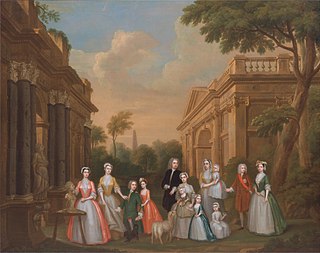
Thomas Watson-Wentworth, 1st Marquess of Rockingham, KB, PC (I) of Wentworth Woodhouse, Yorkshire was a British Whig politician who sat in the House of Commons from 1715 until 1728 when he was raised to the Peerage as Baron Malton.
There have been two "Rockingham Clubs"

This is a list of the principal holders of government office during the premiership of the Earl of Shelburne between July 1782 and April 1783.

This is a list of the principal holders of government office during the second premiership of the Marquess of Rockingham for four months in 1782.

The Rockingham Mausoleum, Wentworth, near Rotherham, South Yorkshire, England is a cenotaph commemorating Charles Watson-Wentworth, 2nd Marquess of Rockingham, who was Prime Minister at the time of his death in 1782. The name by which the memorial is now known is in fact a misnomer, since Charles Watson-Wentworth is buried in York Minster. Eighteenth and nineteenth century sources refer to the edifice simply as "the Monument".